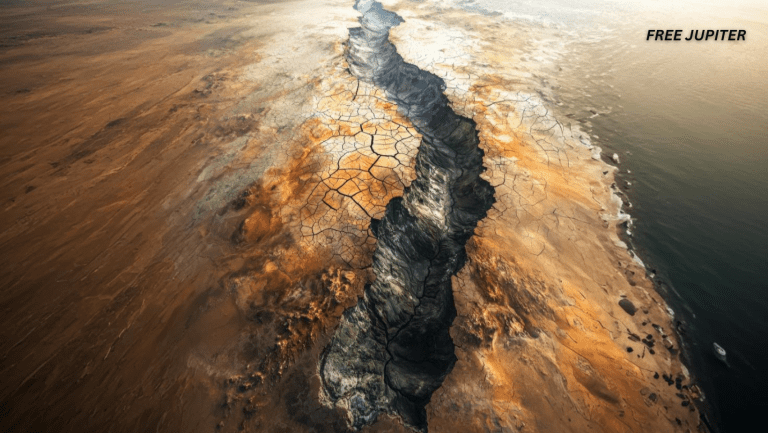What if the sky no longer followed the rules we’ve always known? Imagine a world where the wind no longer flows in familiar directions, temperatures defy seasonal expectations, and storms rewrite their usual playbooks. That’s precisely what NASA has brought to light—a sweeping and profound atmospheric transformation unfolding over North America. This isn’t merely an unusual blip in the weather cycle but a major shift that could redefine the way the continent experiences climate, seasons, and daily weather rhythms. The air above us is changing in real-time, and this new development is causing a stir among meteorologists, scientists, and everyday weather watchers alike.
Let’s delve into the core of this phenomenon—what it means, how it was detected, and what ripple effects it might have on everything from storms to crops.
Decoding Atmospheric Shifts: A Sky in Flux
Atmospheric shifts refer to significant changes in the patterns of air movement and interaction within Earth’s atmosphere. While minor fluctuations are common—such as a sudden gust or change in wind direction—this latest development signifies something far more substantial. NASA’s findings indicate that large-scale rearrangements of air masses are occurring, which in turn are producing unanticipated temperature fluctuations, unusual precipitation patterns, and unpredictable weather events across the continent.
Such rearrangements can bring unusually warm air into colder regions or sweep unseasonal cold into areas typically enjoying warmth. These disruptions throw conventional forecasting into disarray and require communities to adapt with little notice. For those who study weather, this moment feels like watching the atmosphere compose an entirely new song with unfamiliar notes.
NASA’s Watchful Eye: At the Frontlines of Climate Monitoring
NASA has been an enduring force in climate research, utilizing cutting-edge satellites and sophisticated ground-based tools to observe Earth’s dynamic systems. Through its expansive network of orbiting instruments, subtle and otherwise imperceptible changes in wind currents, moisture distribution, and surface temperatures have been documented.
This latest atmospheric shift was detected through precise readings gathered over weeks and months, enabling scientists to pinpoint anomalies and identify developing trends. NASA’s mission goes beyond passive observation; their data informs public policy, aids disaster preparedness, and deepens the global understanding of Earth’s complex systems. Each new insight strengthens the bridge between science and society.
Read more: The Lyrid Meteor Shower Returns: Here’s How and When to Watch the Shooting Stars
Unpacking the Discovery: What the Data Reveals
NASA’s detailed assessment of North America’s atmospheric transformation uncovered several critical changes. Wind flows that generally stream from west to east have started looping unpredictably, causing weather systems to linger in areas longer than usual or shift in unexpected directions. Temperature records have reflected inconsistencies as well—hotter spells in cooler months and sudden chills in times traditionally associated with warmth.
Moisture patterns have also become erratic. Regions previously prone to dryness have encountered unseasonal deluges, while typically wet areas face troubling dry spells. These changes don’t appear in isolation but are part of an interconnected atmospheric web that’s evolving in complexity and sensitivity. With each revelation, the urgency for deeper analysis grows.
Weather Reimagined: Changing Patterns, Changing Lives
The shift in atmospheric behavior is expected to have wide-reaching effects on regional weather. Places accustomed to temperate winters may see more frequent polar air intrusions, while drier zones might face heightened flood risks from intense rainfall. The paths of hurricanes and tornadoes may be altered, creating potential hazards for communities unaccustomed to such threats.
Meteorologists caution that traditional forecasting models are being challenged, and so-called “weather surprises” may become more common. These anomalies could translate to prolonged droughts in some regions, flooding in others, and an overarching sense of unpredictability in day-to-day weather experiences.
Read more: Massive Martian Ice Deposit Could Flood The Entire Planet Under 9 Feet Of Water
Climate Change as the Underlying Force
The observed atmospheric changes are being closely examined in the broader context of climate change. As global temperatures rise, the atmosphere absorbs more energy, which in turn feeds more erratic and vigorous weather systems. Scientists believe that this current shift could be influenced by warming oceans, melting polar ice caps, and disrupted ocean-atmosphere interactions.
These aren’t distant environmental concerns—they affect real lives. Farmers, city planners, and even school administrators are being forced to reckon with new climatic norms. By acknowledging the link between atmospheric instability and climate change, researchers hope to prompt decisive action on a global scale.
Different Regions, Different Realities
The atmospheric shift has not been uniformly felt across North America. Coastal areas have reported increased storm surges and greater vulnerability to flooding. In contrast, inland states are coping with extended drought conditions and colder-than-expected snaps. The Great Plains may become a more active zone for severe weather, while the Northeast could experience increased snowfall and precipitation shifts.
These localized effects demonstrate how geography and existing climate conditions mediate the impact of atmospheric changes. The need for tailored, regional responses becomes clear, as one-size-fits-all solutions may no longer suffice.
The Necessity of Constant Monitoring
With the atmosphere in flux, continuous surveillance becomes not only beneficial but essential. NASA’s real-time satellite observations are crucial in spotting emerging trends, enabling early warnings for dangerous weather events. The ability to monitor shifts in temperature, cloud dynamics, and wind speed allows for a more agile response to potential crises.
But monitoring is only part of the equation. Interpreting this data and relaying it to communities in an accessible and timely manner is what makes a real difference in preparedness and safety.
Building Awareness and Fostering Readiness
Awareness of shifting atmospheric conditions is now a key component of public safety. Educational campaigns, media briefings, and school programs are helping citizens understand the risks and prepare accordingly. From assembling emergency kits to following updated weather forecasts, individuals and communities are learning to become more resilient.
Weather enthusiasts also play a vital role—many serve as neighborhood watchpoints for unusual patterns and share crucial updates online. In this new climate era, knowledge isn’t just power—it’s protection.
Read more: Unraveling The Mystery Of The Indian Ocean’s ‘Gravity Hole’
Technology’s Role in Predicting the Unpredictable
The evolution of technology has elevated weather forecasting to unprecedented levels of precision. Satellites now offer high-resolution imagery, and advanced simulation models provide forecasts that factor in minute-by-minute data.
NASA’s technological prowess underpins many modern forecasting systems, allowing for simulations of how atmospheric conditions might evolve over the coming days, weeks, or even seasons. For professionals and enthusiasts alike, these tools open up new possibilities for observation, analysis, and adaptation.
Toward a Sustainable Future: Climate Action Required
NASA’s findings serve as a clarion call for climate action. Slowing the pace of atmospheric instability will require aggressive reductions in greenhouse gas emissions, broader adoption of clean energy, and protections for natural ecosystems.
Individuals, governments, and corporations all have roles to play. Whether it’s conserving energy at home or passing legislation to reduce emissions, every effort contributes to the larger mission of preserving atmospheric balance. The shifting skies are not only a scientific revelation—they are a moral challenge to adapt, protect, and act.
Redefining Forecasting: A New Era Dawns
With the atmosphere no longer adhering to its old patterns, weather forecasting is entering a transformative period. Innovations in data modeling and AI are empowering forecasters to provide hyperlocal and more accurate predictions. As real-time satellite feeds update forecasts on the fly, weather becomes less about surprise and more about strategy.
The promise of this new era lies in its potential to prevent disasters, guide planning, and support decision-making at every level—from individuals to nations.










